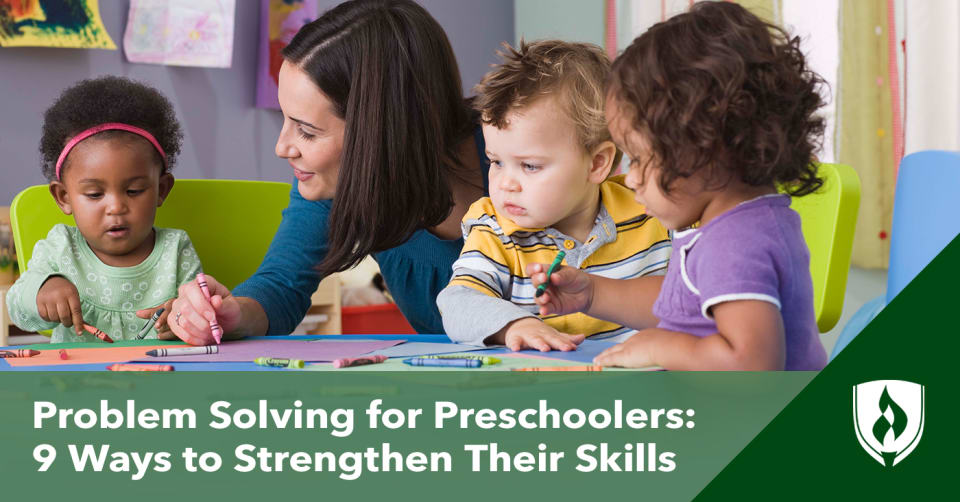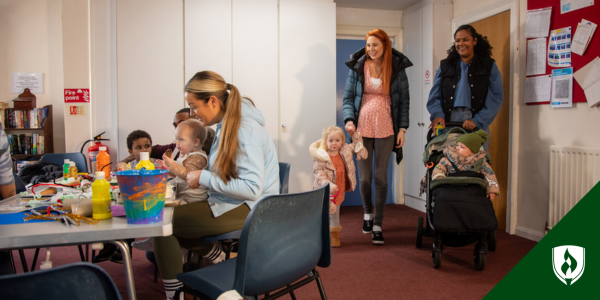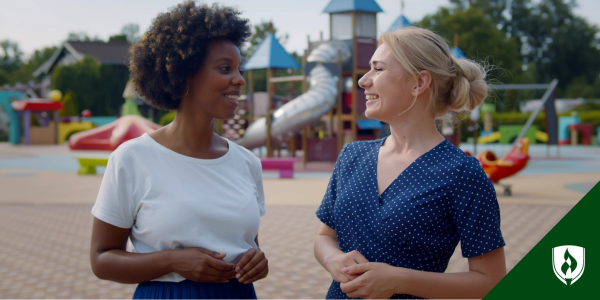Problem Solving for Preschoolers: 9 Ways to Strengthen Their Skills
By Carrie Mesrobian on 12/20/2021

As an adult, you likely run into dozens of small issues every day that require problem-solving skills. While you might not give much thought to the process of figuring out the best way to put groceries away or how to run errands without backtracking all over town anymore, these basic problem-solving abilities weren’t always so simple. You refined these skills as a child with practice and guidance from adults.
Building problem-solving skills in preschool-age children is a foundational duty of all parents and early childhood educators. But it can be easy to lose sight of how to incorporate these skills, especially when family life gets hectic or classrooms become busy.
For some fresh perspective on how to look at problem solving from a preschooler lens, we asked several experts in the early childhood education (ECE) field how they teach skills in their own classrooms. Read on for some insight on helping the young ones in your life figure out creative and workable solutions.
9 Tried-and-true ways to develop problem-solving skills in preschoolers
1. Use everyday moments
The handy thing about teaching problem-solving skills at this age is that there are no textbooks, worksheets or special equipment involved. Every day, normal situations provide all the materials you’ll need to practice.
“Parents can help their children develop problem-solving skills through ongoing interactions with their children throughout their day,” explains Paula Polito, owner of Beary Cherry Tree Child Development Center. “At home, in the grocery store and in everyday routines, such as mealtime or bath time.”
Rebecah Freeling, parent coach and child behavior expert at Wits’ End Parenting®, believes household chores are an excellent way to teach problem solving.
“Housework is a matter of solving one problem after another. All these things go wrong when you’re doing housework,” Freeling explains. “Kids get this idea that problems are no big deal. Problems happen all the time and we just solve them.”
That doesn’t necessarily mean making a chore chart, though Freeling says some kids respond well to them. Instead, she encourages parents to try to integrate kids into the everyday maintenance of the home, and when possible, work alongside them.
“Say, ‘What would you like to be in charge of today?’” Freeling advises. “It’s the difference between getting to do something versus having to do it.”
While a grocery store trip can sometimes be a stressful rush, there are infinite opportunities to practice problem solving, says Dr. Elizabeth DeWitt, senior curriculum and implementation specialist at Learning Without Tears. DeWitt suggests using a list or a recipe of ingredients and asking your child to help you find certain items.
“Say, ‘I have this recipe that says we need chicken, rice and soup. I see chicken and soup in our cart. What are we missing? What could we or should we add?’” DeWitt says.
Taking the time to simply talk children through the thought process—no matter how simple it seems—helps reinforce and show them how you came to that conclusion.
2. Ask open-ended questions
As in the grocery store situation, just asking questions is a powerful way to foster both problem solving and creativity in young children.
“When your child comes across a difficult task, like zipping their coat, it can often be faster and easier to stop what you're doing and zip it for them,” says Becky Loftfield, an ECE teacher at Community of Saints Preschool.
If a child says, “I can't do this,” Loftfield advises asking “how come?” This lets them answer in their own words. “Asking ‘how come’ usually works better than ‘why’ for young children,” Loftfield adds.
Pausing to listen to the child’s explanation of the problem in their own words guides what happens next.
“Perhaps they don't know how zippers line up at the bottom for the mechanism to slide,” says Loftfield. “Maybe the zipper itself is too small for them to grip. Encourage your child to explore what the problem actually is beyond ‘I can't zip my coat.’”
Polito also believes in the power of conversational questions to build problem-solving skills.
“For example, parents can ask a child to explain why they did something a certain way,” Polito explains. “Providing hints to children as opposed to giving them the answer is also another way for children to think deeper about a concept.”
“We promote more learning when we allow them to think through the question,” Polito says.
3. Center emotions
All problem solving involves emotions. In the zipping-up-the-coat situation, a child might act frustrated, get angry or start crying. Handling the emotion is often the key to the child sorting out the situation, as well as learning that they are capable of finding solutions.
“We are not born knowing how to solve problems or having the vocabulary to express our feelings,” says Torri Parker, a pre-K instructor at Aspen Academy. “Often I hear a student telling another child ‘You’re not my friend,’ when what the child is meaning is that they are hurt by something their friend did, or they would like some space.”
Parker suggests picture books that focus on emotions and offer multiple ways to express them can be a powerful way to help kids not only problem solve but also identify emotions in their peers and develop greater empathy.
“By providing the words needed to convey those feelings, a child learns what that feeling feels like and can then have the vocabulary in the future to solve a conflict like that,” Parker says.
4. Read books and tell stories
Sometimes, not having to tackle a problem that’s happening in the moment is a good way to practice these skills. This is where reading books and telling stories come into play.
“Books have the opportunity to build incredible social-emotional skills,” DeWitt says. Not only are kids looking for solutions to the characters’ problems, they’re also building vocabulary, narrative skills and critical thinking as well.
Nicole Evert, a pre-K teacher and ECE trainer at Creating Butterflies, recommends the use of “social stories” for preschool problem solving.
“A social story introduces a problem, then shows successful ways to solve the problem,” Evert explains. “Sometimes a social story will include silly pages that show how to not solve the problem.”
Social stories can be especially helpful for children with anxiety about certain activities or routines, as well as kids with disabilities.
“Parents and educators can even make their own social stories using pictures of the specific child and their environment, which can be so powerful,” adds Evert.
5. Take advantage of natural curiosities and interests
One approach to helping young children practice problem-solving skills is in the discovery of something they are authentically interested in learning about. Adam Cole, music director at The Willow School, explains his school’s Reggio Emilia-inspired philosophy where a teacher gives students “provocations.”
“Provocations are opportunities for them to encounter something for which they may then express further interest,” Cole explains. “For instance, a teacher may set up a drawing provocation, and the children may draw buildings. The teacher may pick up on this and talk with the children about buildings, asking how they are built and where they can find more. This may lead to research or trips to see buildings and will continue on until the thread plays itself out.”
Because the focus is centered on topics or activities that already capture the child’s interest, the problem-solving aspect is more meaningful and compelling for many children. Because the teacher works alongside the child to problem solve, it offers space for the teacher to ask questions and encourage further creativity.
“This is an organic way to learn to solve problems, bolstered by the intrinsic desire of the child to learn more,” Cole adds.
6. Model problem solving
Preschoolers are always observing our behavior as parents and teachers.
“Given that 90% of brain development occurs between birth and four years of age, we have an opportunity during these preschool years to set our children up for success,” says Polito.
It may seem obvious, but our strategies and methods provide kids with in-the-moment examples of how to handle life with things go wrong.
“From a teaching perspective, you can think, ‘I’m teaching this child how to be who they are, how to live life,’” says Freeling. “A spill derails you a bit. So, stop and ask the child, ‘How should I clean this up?’”
Loftfield agrees. “Parents and educators can act as guides for a child’s experience, demonstrating how they problem solve and modeling what they want to see.”
This doesn’t mean that the adult must do everything perfectly or without emotions, however. Managing feelings is all part of learning to problem solve. “Allow time for mistakes, time for meltdowns and time for celebration,” Loftfield advises.
7. Look to the child for the solution
This last one might seem counter to number six above, but Freeling believes that parents and teachers can help children learn to problem solve by removing themselves from the process.
“Moving past your instincts to fix or smooth over problems helps a lot,” Freeling says. “Project the kid’s age in your mind. Think of a 25-year-old graduating from college. I want them to be able to ask for a higher salary, to vocalize what they want. You’re not just getting kids to be obedient—you’re teaching them how to negotiate the world.”
This is why Freeling advises adults to try coming into a problem-solving situation with children without a ready-made solution. She offers an example: there’s only one red truck, and two children both want to play with it.
“You’re really looking to the child and trusting their thinking and intelligence for solutions you hadn’t thought of,” Freeling says. She recommends repeating questions until the kids come to a decision and as long as no one’s at risk of injury, standing by the children’s solution.
“They might say, ‘We have to paint all the trucks red, since everyone wants a red truck,’” Freeling says. This might seem odd to an adult. But the point is to make the children a vital part of the creative process instead of just getting them to comply with the adult’s idea.
Developing empathy also factors into this scenario, especially in situations where problems stem from hurt feelings or other emotional conflicts. Freeling believes that finding ways to make restitution to others they’ve hurt is a better practice than forcing kids to apologize. She suggests having a child draw a picture of something the upset child likes as a way to make amends and help them recognize the other’s individuality.
“We don’t want kids to feel guilt for hurting someone; we want them to feel compassion,” Freeling says. “And solving problems in a relationship requires empathy.”
Is an early childhood education career right for you?
Enjoying the process of seeing life through a little one’s eyes? Early childhood education is an exciting, dynamic field full of creativity and potential to positively impact the lives of children and their families. If helping kids learn and grow sounds like something you’d be good at, check out our article “9 Signs You Should Be Teaching Preschool.”
Related Articles:
- Working with Defiant Preschoolers: What Educators Should Know
- 10 Fun Exercises for Preschoolers That Do More Than Just Burn Energy
Wits’ End Parenting is a registered trademark of Wits’ End Parenting, Inc.
This program does not prepare students for licensed teaching positions in elementary or secondary schools. A Bachelor’s degree and a state teaching license are typically required to work as a teacher in most school settings; however, states, municipalities, districts or individual schools may have more stringent licensing requirements. Childcare facilities and states establish qualifications for staff who work with children, and often implement guidelines regarding age, education, experience and professional development. Students must determine the licensure requirements for the state and facilities in which they intend to work.




